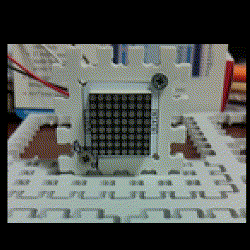3 releases (stable)
| 1.1.0 | Feb 5, 2025 |
|---|---|
| 1.0.0 | Jan 11, 2025 |
| 0.9.0 | Jan 4, 2025 |
#233 in Embedded development
152 downloads per month
21KB
335 lines
Rust IS31FL3728 audio modulated matrix led driver
Usage
Add the following to your Cargo.tml to get is a dependency (check that version is the latest!).
[dependency]
is31fl3728-rs="0.9.0"
Controller support
This crate provides a platform-agnostic driver for the IS31FL3728 LED Matrix. Led driver uses I2C.
Support all features of driver:
- ✅ Audio input with gain selection and audio frequency equalize
- ✅ Array mode selection (8x8 dot matrix, 7x9, 6x10, 5x11)
- ✅ Intensity of the matrix output (from 5mA to 75mA with 5mA step)
- ✅ Software shutdown and return from it.
See IS31FL3728 data sheet for details.
Crate's features
This crate based on embedded-hal version 1.0.
Features:
rtt- enable debug output of communication between your app and led driver.
[!IMPORTANT] You MUST initialize rtt in your application
embedded-graphics- enable support of embedded-graphics. See example
Crate's specifics
The IS31FL3728 uses columns, not rows, as the more popular MAX7219 does. This is why you can't use a 8x8 led matrix editor like this one: https://xantorohara.github.io/led-matrix-editor/ . The library provides a method "draw_bitmap" which solves this trouble.
Instantiating
Create an instance of driver with the new method, by passing initialized I2C and configuration
let i2c = // depends of your MCU and HAL
let matrix_addr: u8 = 0x60;
let mut led_matrix = IS31FL3728::new(i2c, matrix_addr, MatrixDimensions::M8x8, false).unwrap();
Driver is ready to use after creating.
Main methods
draw_column- show column on the matrixdraw- show several columns on the matrix. Use this method for quick update matrix.draw_bitmap- likedraw, but elements in the array are rows. So you can easy use online led matrix editors See more methods for full control.
Examples
Folder examples contains full examples:
- stm32 - tested on Nulceo-64 F401RE
- embedded-graphics - simple sprite's animation.
Quick code (STM32)
#![deny(unsafe_code)]
#![no_main]
#![no_std]
use is31fl3728_led_matrix::{LightingIntensity, MatrixDimensions, DEFAULT_LIGHTING_INTENSITY, IS31FL3728};
// Halt on panic
use panic_halt as _;
use rtt_target::rtt_init_print;
use cortex_m_rt::entry;
use stm32f4xx_hal::{self as hal, gpio::GpioExt, i2c::I2c, pac, prelude::*};
#[allow(clippy::empty_loop)]
#[entry]
fn main() -> ! {
rtt_init_print!();
let dp = pac::Peripherals::take().unwrap();
let rcc = dp.RCC.constrain();
let clocks = rcc.cfgr.use_hse(8.MHz()).sysclk(84.MHz()).freeze();
let mut delay = dp.TIM5.delay_us(&clocks);
let gpiob = dp.GPIOB.split();
let pb8_scl = gpiob.pb8;
let pb9_sda = gpiob.pb9;
// Initiation of I2C
let i2c1 = I2c::new(
dp.I2C1,
(pb8_scl, pb9_sda),
hal::i2c::Mode::standard(400.kHz()),
&clocks,
);
let matrix_addr: u8 = 0x60;
let mut led_matrix = IS31FL3728::new(i2c1, matrix_addr, MatrixDimensions::M8x8, false).unwrap();
led_matrix.clear().unwrap();
let picture = [
0b00000000,
0b01100110,
0b11111111,
0b11111111,
0b11111111,
0b01111110,
0b00111100,
0b00011000,
];
led_matrix.draw_bitmap(&picture).unwrap();
led_matrix.set_intensity(LightingIntensity::C20mA).unwrap();
loop {
led_matrix.software_on().unwrap();
led_matrix.set_intensity(LightingIntensity::C10mA).unwrap();
delay.delay_ms(150);
led_matrix.set_intensity(LightingIntensity::C25mA).unwrap();
delay.delay_ms(150);
led_matrix.set_intensity(DEFAULT_LIGHTING_INTENSITY).unwrap();
delay.delay_ms(500);
led_matrix.set_intensity(LightingIntensity::C25mA).unwrap();
delay.delay_ms(150);
led_matrix.set_intensity(LightingIntensity::C10mA).unwrap();
delay.delay_ms(150);
led_matrix.software_shutdown().unwrap();
delay.delay_ms(300);
}
}
Result of application:
Dependencies
~55–320KB
